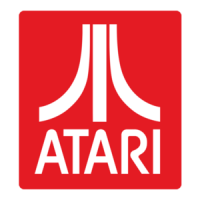pushbutton.
The
ball
may
be
served
whenever
de-
sired,
by
pressing
the
flashing
red
LED
pushbutton.
Before serving the ball, the Progressive Breakout
playfield contains
two
4 X 13 brick walls (one blue and
the other green). The
blue brick wall, which consists
of
52
hricks,-isatthe
top.
Then
occurs
a space
equivalent
to
this
wall.
In
the
middle
of
the
screen
is
a green
brick
wall
consisting
of
52
bricks.
The
brick
walls
move
or
"scroll"
toward
the
pad-
dle
at a rate
determined
by
the
number
of
hits
on
the
ball.
As
the
bricks
are
knocked
out
and
the
walls
progressively
creep
up
on
the
player's
paddle,
new
brides
enter
the
playfield
at a progressively faster
rate;
four
rows
of
bricks
are always separated
by
four
rows
of
blanks.
As
the
brick
walls
scroll
down,
their
colors
change (see Figure 2-9)
which
indicates a
new
point
score
for
that
brick
at
that
instant
of
time.
There
are
four
different
colors
of
bricks,
each
color
with
a
dif-
ferent score value. The blue bricks are worth 7 points
when
struck
by
the
ball, 5
points
for
each
orange
brick,
3
points
for
each
green
brick
and 1
point
for
each
yellow
brick.
See Table 2-3
for
a
quick
and easy
reference. Bricks
that
scroll
off
the
bottom
of
the
screen are lost
and
are
not
counted
toward
or
against
the
player's score.
Table 2-3 Progressive Breakout Scoring Chart
Color Points per Brick
blue
7
orange
5
green
3
yellow
1
The
maximum
attainable
score
for
progressive
Breakout
is
infinite.
Ball
Speed
Besides
the slowest ball speed already described
(right after the
serve),
there are three possible speed-ups.
The first speed-up after the serve occurs on the 4th hit,
and a second faster speed-up occurs on the 8th hit. The
third occurs after the 12th
hit
and the fourth occurs
when a highpoint (either a
5-
or 7-point) brick
is
hit,
regardless
of
previous speed. Ball speed
is
restored
to
the slowest value at the beginning
of
each
serve.
Ball
Direction
When
the
ball
intercepts
the
paddle
it
will
re-
bound
in
any
of
four
directions,
depending
on
which
portion
of
the
paddle
was
hit
(see Figure 2-10). This
is
still
the
case
after
the
paddle
has
been
reduced
to
half
its
normal
size.
Note
that
the
ball
is
not
allowed
to
move
in
a
direction
perpendicular
to
the
front
surface
of
the
paddle
or
perpendicular
to
the
edge
of
the
paddle.
These
directions
change
with
the
number
of
hits
of
the
ball,
just
like
the
ball speed changes
occur
at
the
4th,
8th and 12th ball hits.
BALL
DIRECTIONS
NOTES:
1.
Angle
of
rebound
is
determined
by
which
por-
tion
of
the
paddle
that
the
ball hits.
The
ball's
angle
of
incidence
is
irrelevant.
2.
The
angles
of
rebound
become
more
perpen-
dicular
as
ball
speed
increases.
3.
The
diagram
above,
with
four
sections,
still
applies
after
paddle
width
has
been
reduced
to
half
the
normal
value.
Figure 2-10. Diagram
of
Ball Rebounds
off
Paddle
The
player
must
hitthe
ball
first,
otherwise
bricks
cannot
be
knocked
out,
and
the
ball
will
pass
through
all
the
bricks
in its path. The ball
with
also pass
through
any
bricks
if it
has
not
gone
at least
four
rows
from
the
last
brick
hit,
and
not
hit
the
paddle
or
the
uppermost
boundary
at
the
top
of
the
screen.
Immediately
on
hitting
the
uppermost
boundary
at
the
top
of
the
screen
the
paddle(s)
will
reduce
to
half
its
width
until
the
next
serve
if
any.
2-15

